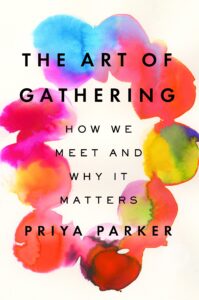 My love of facilitating is closely matched by a love of making other gatherings in life meaningful. Hosting a great birthday party or dinner soirée can bring a deep level of satisfaction, just as hosting a daylong conference on civic engagement, a retreat on affordable housing or a design session on health equity in rural communities can rock my boat.
My love of facilitating is closely matched by a love of making other gatherings in life meaningful. Hosting a great birthday party or dinner soirée can bring a deep level of satisfaction, just as hosting a daylong conference on civic engagement, a retreat on affordable housing or a design session on health equity in rural communities can rock my boat.
Imagine my delight when a dear friend gifted me a copy of The Art of Gathering by Priya Parker. Parker, a professional facilitator trained in conflict resolution, explores how we gather in personal and professional venues, and illustrates just how much intention goes into connecting people to one another and to the larger purpose of our work and world.
Parker defines a facilitator as someone who is trained in the skill of shaping group dynamics and collective conversations, and goes on to share lessons learned on what works in the art of gathering. Here are two themes I found particularly resonant with my own facilitation practice.
Commit to a bold, sharp purpose
Too often our reasons for gathering are under-examined or muddled.
“We always have an annual conference,” we say to ourselves, and so we go about the tasks of finding a venue, lining up speakers and planning what’s in the give-away bags. We don’t examine the reasons why we’re gathering, and so we don’t design for that deeper purpose.
In my experience, people rarely gather for a single purpose: to gain knowledge or to meet new people. We are drawn to gathering because we yearn to connect more deeply with one another, to sense-make and to advance our understanding of the complex world we navigate. By committing to a purpose that sings with deeper meaning, we can start to design for what we want rather than what we’ve always done. A compelling purpose then guides decisions about who attends, what’s discussed and how, and even where the event takes place.
A signature high school graduation initiative I once helped lead, Graduation Matters Montana, held high-energy, fun annual gatherings that pushed local communities to dig deeper into their own learning and doing.
- Our purpose was to build the capacity of local communities through peer learning.
- Who attended were teams of students, school staff and community members from a school district who could learn and do together at the event and later, at home.
- How we gathered was at round tables, with pre-assigned seating with like-sized communities. We ensured there was a facilitator at each table to support deep conversation about their work. We included a “TED-talk”-inspired event to share inspiration, learning and laughter. Participants left our gatherings energized and committed to the work ahead.
Protect the gathering and the people in it
Parker admonishes us, “Don’t be a chill host.” Step into the role of setting expectations and supporting a group to adhere to those expectations. Protect your guests from boredom, from unclear rules and unclear roles. Wield practices that honor the purpose, at every turn.
Parker uses the term “generous authority” to describe the role a facilitator plays to create safe spaces for people to take risks, be authentic and truly connect; to ensure that the purpose is clear and time is well spent.
I’ve often used the term “facilitative leader” to describe a similar role. I envision my role is to hold the space for people to do their work together in thoughtful, creative and enlivening ways. Practices that help to clearly communicate – and deliver – for participants include:
- Establish and enforce ground rules that explicitly invite in an equalization of power and hierarchy The ground rules I use, adapted from the National Equity Project, include “We acknowledge each other as equals.” I explain that we each have a unique set of experiences, education and training, that we come to this work through our own set of experiences, and that this is what makes our work together powerful.
- Don’t be afraid to be a wedding planner I often pre-assign people to tables I think will generate thought-provoking and productive conversation. In our virtual meeting space, I pre-assign Zoom breakout rooms, rather than letting them be randomly assigned.
- Know that connections don’t always happen on their own
At the beginning of a gathering, I often have people participate in Impromptu Networking. On line, I design thoughtful chat box introductions, such as “What’s one thing you did this past weekend that helped restore balance in your life?”
Now more than ever, we have a need to connect more deeply and more productively to one another. Books like Parker’s are a rare treat for those of us who relish hosting memorable gatherings. Nowadays, many of our gatherings are held in the virtual world. I’ll share some of what I’m learning on hosting great virtual gatherings in my next blog post.
Until then, let me know what you think about the Art of Gathering in your life.

Thanks, Deb. I’m glad that I opened this email and read the blog. I’ll look forward to the next blog post. Gathering on Zoom has been convenient, fun and productive for me as I’m not a person who has a bizillion Zooms a day. So each one stands out and matters. Hope you and yours are doing well. Peggy
I’m so glad, Peggy! Zoom definitely has allowed for good connecting this past year. It’ll never replace a hug and a kiss, but can be a bridge to our community and loved ones in the meantime…
Hi Deb, thank you for this interesting post. Now you have me wondering about personal gatherings, and how these principles of generous facilitation can apply to those. I’m reminded of your birthday celebrations and solstice gatherings. Always so sweet.
Thank you, Maureen! Yes, one of the things I really like about Parker’s book is how she draws parallels between personal gatherings and professional ones, and how the roles of purpose, intent, hosting, fun and risk can help our gatherings meet our soulful needs… As you know so well in your marvelous art gallery openings and events. Love you!
I love this Deb. And you have brought this thoughtfulness to me professionally and personally. Thank you!
Thank you, Liz! I likewise learn and grow alongside you.